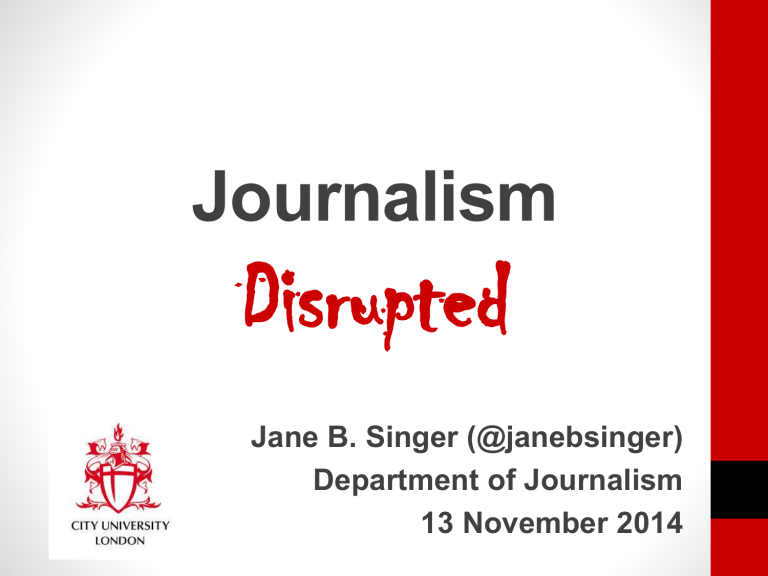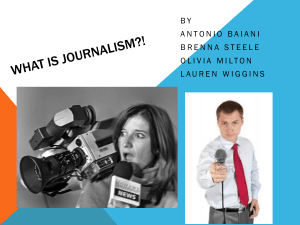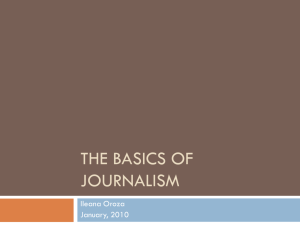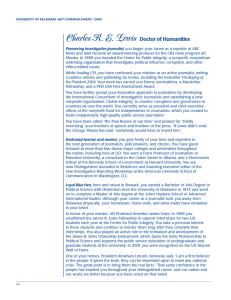Disrupted Journalism Jane B. Singer (@janebsinger) Department of Journalism

Journalism
Disrupted
Jane B. Singer (@janebsinger)
Department of Journalism
13 November 2014
Plus ça change …
1969
… and 2014
La-la-la-la-la-lala …
I’m going to pretty much ignore the tabloids because:
• I don’t know a lot about them. Poor excuse, I realise.
• Here’s a better one: From what I can see, they are less ‘disrupted’ than many. Their audience is huge and in some cases ( Daily Mail online, I’m looking at you) growing nicely, as is their revenue.
Their business plan – outrage and titillate, and keep the per-copy price low – still works brilliantly, sad to say.
•
Is it journalism?
Let’s go with ‘no’.
Four premises
1.
Journalists are very strongly socialized to think like and to identify with … other journalists.
2.
They tend to believe that ‘ journalist’ = ‘reporter .’
3.
They seek to draw boundaries around themselves and what they do – who is a journalist, what is journalism – and those boundaries generally involve ethics , or ideas about normative practice.
4.
Those ethics are, typically, utilitarian in nature. Not a problem by itself, but utilitarianism can easily slip into ‘ the ends justify the means ’ sorts of reasoning. Audiences often see things differently.
The ends justify the means?
Percentage of journalists saying these may be justified:
Using confidential biz or gov’t documents without permission
Getting employed to gain info
Using hidden mics or cameras
UK journos
(pro, 1995)
86%
80%
73%
UK journos
(student, 2006)
36%
78%
85%
Paying sources for info
Badgering unwilling informants
65%
59%
77%
43%
Using personal documents without permission
49% 24%
Claiming to be somebody else to gain info
47% 70%
Sources: Delano and Henningham, The News Breed , 1995
Ball, Hanna and Sanders, “What British Journalism Students Think …”, 2006
Willnat and Weaver, “The American Journalist in the Digital Age,” 2014
US journos
(pro, 2014)
58%
25%
47%
5%
38%
25%
7%
Journalism practice disrupted
Since the mid-1990s, massive changes include:
•
Tools of the trade , obviously, and the skills needed to use them effectively.
•
Nature of tasks that are expected / required.
•
Relationships with audiences (including the idea of even having such a ‘relationship’).
•
Nature and extent of competition , the
‘who is a journalist / what is journalism’ issue.
•
Precarious and often piecemeal nature of employment – not new, but more widespread.
Journalism business disrupted
Since the mid-1990s, massive changes include:
•
Steep, steady, ongoing decline in audience for legacy products, especially newspapers.
•
Corresponding decline in revenue , including from both display and classified adverts.
•
An audience fragmented in at least two important ways: lured by competitors (many new) and far less interested in whole ‘package.’
•
Explosion in scale and scope of competition .
Birds of a feather …
•
And finally, a misinterpretation by management of fundamental structural change as cyclical.
The digital impact continues to expand, fast.
The need for change has only grown more pressing.
It was 20(plus) years ago today …
… Give or take, that the Web browser emerged from the lab. For journalists, there was no going back – though not necessarily for want of trying.
Common responses to successive waves of technological change followed a pattern. For many
(not all, but many), first came trepidation , then …
Resistance as a badge of honour.
Hang on, this might actually be useful .
In fact, we can’t imagine living without it .
Of course, you never said this
But maybe you heard something like it from others:
•
Trepidation : OMG, I’ve not a clue how this thing works!
•
Resistance : … But that’s OK because it’s clearly going to result in ethically problematic journalism. And the skills that really matter – aka the ones I happen to have
– are far more important anyway. So I’ll lay low because:
1.
It’s hard (to understand, master and / or use wisely).
2. I don’t really need it to do my job well.
3. It endangers our high professional standards .
The Internet (mid/late 1990s)
• It’s hard : ‘Every day that goes by that I’m not trained on how to use the Internet, every day I remain afraid of the computer
… it’s like the opposite of going to the dentist. I want that help, but every day I don’t get it, I get more and more nervous.’
(US journalist)
• I don’t really need it: ‘It wasn’t the printing press that changed the world. It was good journalism. The same goes for high tech.’
(US journalist)
• It’s ethically dangerous: ‘In print, we’ve always had the luxury of, well, let’s see if what we have immediately is actually true and the whole story and can be verified. The old adage was, “Get it first, but first, get it right.” Well, now it’s just “get it first.” ’
(US journalist)
Multimedia (early 2000s)
• It’s hard
:
‘Journalists who had been working in print for 10 years and then suddenly also had to tell stories in radio and television experienced a lot of frustrations when using cameras or new techniques they were not familiar with.’
(Spanish journalist)
• I don’t really need it: ‘“I went to j-school to be a journalist, not to be a multimedia person, not to be a TV person, not to multitask. … I have never liked TV journalism. I’ve always thought it’s abhorrent, a sub-species.”
( US [newspaper] journalist )
• It’s ethically dangerous: Multimedia journalists ‘have no real relationship with just the tools of news gathering and just the thought processes of getting a story together other than effectively plug some holes. And the danger is course that the site will go into that culture and lose that original journalism thing .’
(British journalist)
Bloggers and UGC (mid-2000s)
• It’s ethically dangerous (and a major time suck) : The value of user-generated content is ‘disproportionate to the excessive amount of management time which is taken up with trying to ensure it is accurate, balanced, honest, fair and – most importantly
– legally safe to publish.’
( British journalist )
• It’s ethically dangerous (and less valuable than what I do): ‘It’s vanity journalism. “Oh look at me, I can express an opinion on something”. And I’m too much of an old-style journalist, you know I still put value on fairness and balance and everything else. And I don’t particularly care, generally, what most ill-informed people out there who appoint themselves pundits think. Because basically it’s drinking bath water .’
( Canadian journalist )
• It’s ethically dangerous (have I mentioned that?): Bloggers
‘publish because they hear “something” from “someone” who is
“reliable.” Sorry, not good enough.’
( US journalist)
Social media (late 2000s)
• It’s not hard at all – and that’s a problem
:
“It’s like searching for medical advice in an online world of quacks and cures.”
(US journalist)
• I don’t really need it: ‘What could be more annoying and less useful than a site where thousands of people are given 140 characters to shout out about what they’re doing at every moment?
’
(Advertising Age)
• It’s ethically dangerous: ‘Social networks encourage fast, constant, brief communications; journalism calls for communication preceded by fact-finding and thoughtful consideration. Journalism has many “unsend” buttons, including editors. Social networks have none.’
(Reuters)
How did we survive without it?!?
Yet journalists today would find it all but unimaginable to get along without the Internet, to publish a substantive story without visuals, to cover a beat without Twitter.
Every one of those innovations has ultimately enabled us to produce better journalism : more engaging, more multi-faceted, more accessible to more people in more ways and more places.
‘Fifty years after the printing press, we did not have old Europe plus the printing press.
We had a different Europe.’
~ Neil Postman, Technopoly
Twenty years after the Internet, we do not have old newsrooms plus the Internet. We have new newsrooms .
The future is mutual
‘I’ve seen the future, and it’s mutual.’
~ Guardian editor Alan Rusbridger
As journalists have adapted to social media, we’ve seen:
•
Renewed attention to, and expansion of, verification processes.
•
An opening to more, and more diverse , views.
•
The provision of updates, tips and insights once unavailable to all but the most well-staffed outlets.
•
More direct and overt accountability , such as through immediate communication about errors or ‘work in progress’.
•
More broadly, an increased emphasis on transparency .
What’s not to like?
The view from the executive suite
To news media executives, Digital Age Episodes I, II and III looked something like this:
•
Mid/late 1990s:
Denial : ‘There’s nothing to worry about here.’
New medium, old revenue model : If you build it
(and give it away), audiences/advertisers will come.
•
Early 2000s :
Separate and unequal: Online, on the cheap.
Me-tooism: Lots of imitation, little innovation.
•
Late 2000s:
RECESSION!! Mega-smackdown.
Time for a rethink!
Diverge and conquer
The way forward into the (undoubtedly) digital future is not uniform but variable .
For the first time in a long time, commercial news organizations whose legacy products look the same and make money in more or less the same way are pursuing revenue options that are not only new but also dramatically diverse.
Membership:
Community identity builds loyalty
(‘I’m in the club:
I’m a
Guardian reader.’)
Event hosting
Crowd-funded journalism
Don’t say
‘paywall.’
Do say
‘membership.’
The way forward?
•
For journalists: I’m going to end with … ethics.
Not (just) the old inward-facing kind, but (also) a outward-facing version of relationship ethics .
The former boundaries may indeed be gone – and that is, in more ways than not, a good thing.
•
For news organizations : Invest concerted and creative thought into a) who you are and what you do well b) who your audience is and what they expect of you and c) ways, including novel ones, to bring in the money you need to preserve your identity, your audience and your value.
Change demands change.
The best (only?) response to
disruption
is
innovation
.



